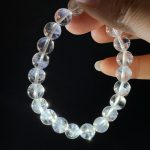Pyrite, a lustrous golden mineral, and quartz, a transparent silica crystal, form a captivating combination known as pyrite in quartz. This symbiotic union has captivated humans for centuries, symbolizing wealth, creativity, and spiritual guidance. Let’s delve into the fascinating world of pyrite in quartz, revealing its geological significance, historical reverence, and remarkable applications.

Formation and Composition
Pyrite, also known as “fool’s gold,” forms under high temperatures and pressures within the Earth’s crust. Its cubic crystal structure and golden luster often resemble gold, hence its nickname. Quartz, on the other hand, forms from molten magma as it cools and crystallizes. When these two minerals co-crystallize, they form pyrite in quartz.
Geological Significance
Pyrite plays a vital role in the Earth’s geochemical processes. It acts as a catalyst for various chemical reactions and facilitates the formation of other minerals. Its presence in quartz provides insights into the geological conditions under which the rock formed. The size, shape, and distribution of pyrite crystals within quartz can reveal information about temperature, pressure, and chemical composition during rock formation.
Historical Reverence
Pyrite in quartz has been revered for centuries across different cultures. The ancient Egyptians believed it held protective powers and used it in amulets and talismans. In medieval Europe, it was associated with wealth and prosperity. The Inca civilization of South America considered pyrite sacred and used it in rituals and ceremonies.
Spiritual Significance
Pyrite in quartz is often associated with spiritual growth and transformation. It is believed to promote clarity, creativity, and abundance. Some crystal healers claim that it helps alleviate anxiety, boost confidence, and enhance intuition. However, these claims lack scientific validation.
Applications
Beyond its geological and spiritual significance, pyrite in quartz finds practical applications in various fields:
-
Jewelry and Decoration: Pyrite in quartz is prized for its unique golden luster. It is used in jewelry making, creating stunning pendants, earrings, and rings. It also adds a touch of opulence to home décor, used in decorative pieces, sculptures, and tabletops.
-
Industrial Uses: Pyrite is a valuable source of sulfur, an essential element for sulfuric acid production. It is also used in the manufacture of fertilizers, pigments, and electronic components.
-
Pyritual Applications: A creative term coined to describe the potential applications of pyrite in quartz. Researchers are exploring its use as a catalyst for fuel cells, improving energy efficiency. It also shows promise in enhancing solar cell performance and as a potential antimicrobial agent.
Tables for Reference
Table 1: Physical Properties of Pyrite and Quartz
| Property | Pyrite | Quartz |
|---|---|---|
| Chemical Formula | FeS2 | SiO2 |
| Crystal Structure | Cubic | Hexagonal |
| Color | Golden Yellow | Transparent |
| Luster | Metallic | Vitreous |
| Hardness | 6.0-6.5 | 7.0 |
Table 2: Geological Significance of Pyrite in Quartz
| Parameter | Significance |
|---|---|
| Crystal Size | Temperature and pressure during formation |
| Crystal Shape | Chemical composition of the environment |
| Distribution | Geochemical processes |
Table 3: Spiritual Beliefs Associated with Pyrite in Quartz
| Culture | Belief |
|---|---|
| Ancient Egyptians | Protection and power |
| Medieval Europe | Wealth and prosperity |
| Inca Civilization | Sacred and ritualistic |
Table 4: Applications of Pyrite in Quartz
| Field | Application |
|---|---|
| Jewelry and Decoration | Pendants, earrings, decorative pieces |
| Industrial Uses | Sulfur source, fertilizers, pigments |
| Pyritual Applications | Fuel cells, solar cells, antimicrobial agents |
Why Pyrite in Quartz Matters
Pyrite in quartz is a captivating fusion of geology, history, and spirituality. Its unique characteristics and potential applications make it a valuable resource for both science and art. Understanding its formation, composition, and significance can enhance our appreciation of the Earth’s geological processes and the cultural significance it holds.
How Benefits
Pyrite in quartz offers numerous benefits:
- Scientific Insights: Provides valuable information about geological conditions and geochemical processes.
- Aesthetic Appeal: Enhances jewelry and decorative pieces with its golden luster.
- Spiritual Fulfillment: Promotes clarity, creativity, and personal growth (subjective beliefs).
- Industrial Applications: Sulfur source for industrial processes and technological advancements.
- Pyritual Potential: Opens up new possibilities for energy efficiency, renewable energy, and antimicrobial applications.
Pros and Cons
Pros:
- Unique and captivating appearance
- Geological and historical significance
- Spiritual and metaphysical beliefs
- Industrial and pyritual applications
- Relatively affordable and accessible
Cons:
- Can tarnish or oxidize over time
- Symbolism and beliefs may vary across cultures
- Scientific validation for spiritual claims is lacking
- Environmental impact during mining and processing
Conclusion
Pyrite in quartz is a fascinating natural treasure that has captivated humanity for centuries. Its geological origins, historical reverence, and spiritual significance make it a unique and multi-faceted gem. As scientific research continues to uncover its potential, the future holds promising applications for this ancient mineral. Whether admired as a symbol of wealth or utilized for its industrial or pyritual properties, pyrite in quartz continues to inspire and enchant us with its timeless allure.




























